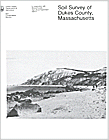The following map unit description is from the published "Soil Survey of Dukes County, Massachusetts"

Soil Survey of
Dukes County Massachusetts
The following map unit description is from the published "Soil
Survey of Dukes County, Massachusetts"

KeA-Klej loamy coarse sand, sandy substratum, 0 to 5 percent slopes. This soil is very deep, nearly level to gently sloping, and moderately well drained. It is in depressions and in low areas adjacent to bodies of open water. The areas of this soil are irregular in shape and range from 5 to 40 acres. They make up about 1 percent of the survey area.
Typically, the surface is covered with a 3-inch-thick layer undecomposed and decomposed leaves and twigs. The surface layer is light brownish gray loamy coarse sand about 4 inches thick. The subsoil is about 26 inches thick. The upper 7 inches of the subsoil is dark brown loamy coarse sand, and the lower 19 inches is yellowish brown coarse sand. The subsoil is mottled at a depth of 27 inches. The substratum is mottled, yellowish brown coarse sand to a depth of 60 inches or more.
Included with this soil in mapping are small areas of Carver, Pompton, and Tisbury soils. Also included are a few places where the subsoil and substratum are gravelly. Included areas make up about 20 percent of this unit.
The permeability of this Klej soil is rapid or very rapid throughout. Available water capacity is very low. The seasonal high water table is at a depth of 1.5 to 3.5 feet in winter and spring.
Most areas of this soil are in woodland. Some areas are in cropland.
This soil is suited to cultivated crops and to pasture and hay. The very low available water capacity and the seasonal high water table are the main limitations for cultivated crops. Erosion is a hazard on the gently sloping cleared areas. The main management practices for crops are drainage, irrigation during dry periods, using cover crops, and incorporating crop residue and manure into the surface layer. The main pasture management concern is the prevention of overgrazing and surface compaction, which reduce the hardiness and density of plants. The use of proper stocking rates and restricting grazing and equipment use during wet periods help to maintain plant densities and reduce surface compaction.
This soil is fairly well suited to woodland productivity. Droughtiness causes a high rate of seedling mortality. Minimizing soil disturbance to retain the mulch of leaves and designing regeneration cuts to maintain shade and reduce evapotranspiration will help to retain the limited soil moisture. The common trees on this soil are white oak, black oak, scarlet oak, and red maple.
The seasonal high water table is the main limitation of this soil as a site for buildings and septic tank absorption fields. The permeability in some areas of this soil prevents adequate filtering of septic tank effluent, causing a pollution hazard to ground water. Using drainage or fill helps to overcome the water table. Low density housing reduces the volume of effluent, thus lessening the pollution hazard.
This soil is in capability subclass IIIw.